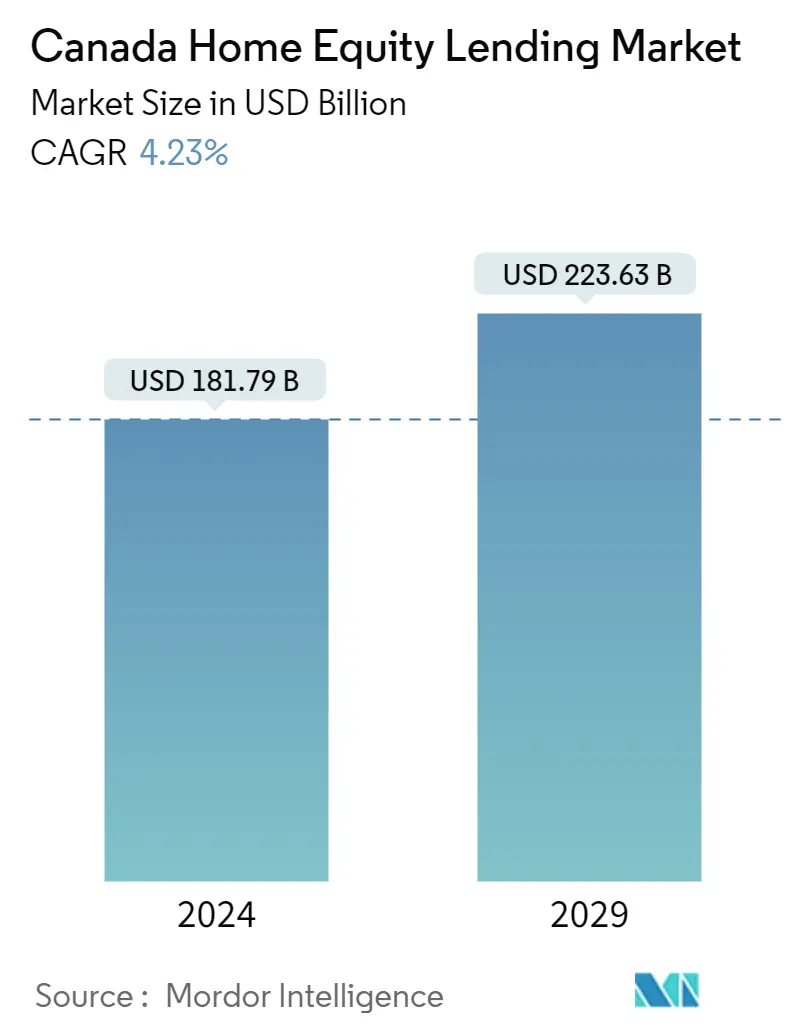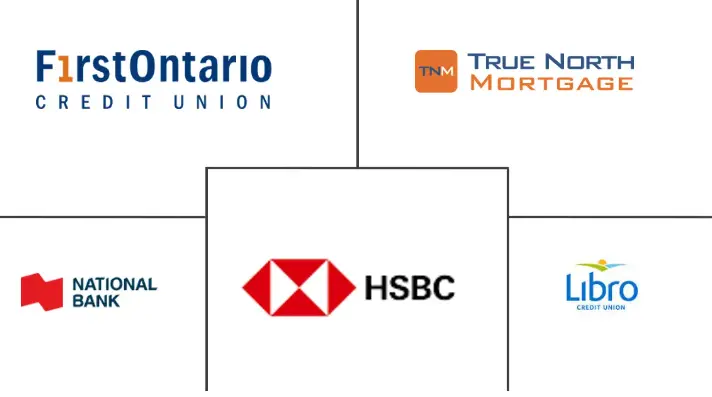Market Size of Canada Home Equity Lending Industry

| Study Period | 2020 - 2029 |
| Base Year For Estimation | 2023 |
| Market Size (2024) | USD 181.79 Billion |
| Market Size (2029) | USD 223.63 Billion |
| CAGR (2024 - 2029) | 4.23 % |
| Market Concentration | Medium |
Major Players
*Disclaimer: Major Players sorted in no particular order |
Canada Home Equity Lending Market Analysis
The Canada Home Equity Lending Market size is estimated at USD 181.79 billion in 2024, and is expected to reach USD 223.63 billion by 2029, growing at a CAGR of 4.23% during the forecast period (2024-2029).
The market for home equity loans has witnessed substantial growth in Canada and is projected to sustain its expansion in the foreseeable future. Home equity loans, a type of consumer debt or second mortgage, allow homeowners to borrow against the equity in their homes. It is a second mortgage taken out on top of the original mortgage used to purchase the home. Homeowners can access additional funds using the equity they have built in their homes. The amount that can be borrowed through a home equity loan is determined by subtracting any outstanding mortgages on the home from its current value. Home equity loans provide substantial funds, and the eligibility requirements for these loans are generally more accessible than other types of loans. Additionally, homeowners can use their homes as collateral for these loans.
Housing prices in Canada have increased in the past six years after a long period of stagnation. This rise, while moderate compared to other countries, is fueled by increased mortgage debt. Higher real estate values and lower regulatory restrictions encourage Canadians to use their homes as collateral. Residential mortgage debt constitutes a significant portion of Canada's household debt, making up 74%. This type of debt plays a crucial role in building net worth for individuals. In contrast, lines of credit comprise 16% of household debt, while credit card debt accounts for a smaller percentage at 4%.
New mortgage rules were implemented in the previous year, making it difficult for Canadians to access their home equity via traditional methods. These requirements also came with increased interest rates, making qualifying for a home equity line of credit solutions more challenging than ever. One change is that under the new rules, Canadians must now be able to pay off their home equity line of credit within 25 years.
Canada Home Equity Lending Industry Segmentation
A home equity loan allows a person to borrow money by using the equity in their home as security. This type of loan can be a second mortgage, a line of credit, or a combination of secured lending options. Often called a second mortgage, it is popular among homeowners because of its lower interest rates than unsecured loans, making it a desirable choice for those who own a home.
The Canadian home equity lending market is segmented by type, service providers, and mode. By type, the market is segmented into fixed-rate loans and home equity lines of credit. By service providers, the market is segmented into commercial banks, financial institutions, credit unions, and other creditors. By mode, the market is segmented into online and offline. The report offers market sizes and forecasts in terms of value (USD) for all the above segments.
| By Type | |
| Fixed Rate Loans | |
| Home Equity Lines of Credit |
| By Service Provider | |
| Commercial banks | |
| Financial Institutions | |
| Credit Unions | |
| Other Creditors |
| By Mode | |
| Online | |
| Offline |
Canada Home Equity Lending Market Size Summary
The home equity lending market in Canada is experiencing a dynamic phase, driven by rising housing prices and increased mortgage debt. Over the past few years, Canadian housing prices have seen a moderate increase, spurred by the use of homes as collateral for loans. This trend has been further supported by the easing of regulatory restrictions, encouraging more Canadians to leverage their home equity. Despite the challenges posed by the pandemic, such as mortgage deferrals and a decline in household income, the market has shown resilience. The balance of home equity lines of credit has seen a notable increase, reflecting the growing reliance on home equity as a financial resource. However, new mortgage rules implemented in 2022 have made it more challenging for Canadians to access home equity through traditional methods, with increased interest rates and stricter repayment terms.
The market landscape is characterized by the presence of major players such as HSBC Bank, National Bank of Canada, and First Ontario Credit Union, who dominate the market share. These institutions are increasingly focusing on technological advancements and product innovation to expand their market presence. The merger between First Ontario Credit Union and Heritage Savings & Credit Union, along with partnerships like that of Hello Safe and Hard Bacon, highlight the strategic moves being made to enhance service offerings and tap into new markets. The growth of home equity lines of credit and combined mortgages underscores the market's expansion, with low-interest rates playing a crucial role in this resurgence. As the market continues to evolve, these key players are likely to maintain their influence while adapting to the changing regulatory and economic landscape.
Canada Home Equity Lending Market Size - Table of Contents
-
1. MARKET INSIGHTS AND DYNAMICS
-
1.1 Market Overview
-
1.2 Market Drivers
-
1.2.1 An Increase in Residential Properties
-
1.2.2 Massive Increase in Home Prices
-
-
1.3 Market Restraints
-
1.3.1 Time Frame of the Mortgage Loan Process
-
-
1.4 Market Opportunities
-
1.4.1 Development of New Lending Technologies
-
-
1.5 Industry Attractiveness - Porter's Five Forces Analysis
-
1.5.1 Bargaining Power of Suppliers
-
1.5.2 Bargaining Power of Buyers
-
1.5.3 Threat of New Entrants
-
1.5.4 Threat of Substitutes
-
1.5.5 Intensity of Competitive Rivalry
-
-
1.6 Insights on Various Regulatory Landscapes
-
1.7 Insights on Impact of Technology and Innovation in the Market
-
1.8 Impact of COVID-19 on the Market
-
-
2. MARKET SEGMENTATION
-
2.1 By Type
-
2.1.1 Fixed Rate Loans
-
2.1.2 Home Equity Lines of Credit
-
-
2.2 By Service Provider
-
2.2.1 Commercial banks
-
2.2.2 Financial Institutions
-
2.2.3 Credit Unions
-
2.2.4 Other Creditors
-
-
2.3 By Mode
-
2.3.1 Online
-
2.3.2 Offline
-
-
Canada Home Equity Lending Market Size FAQs
How big is the Canada Home Equity Lending Market?
The Canada Home Equity Lending Market size is expected to reach USD 181.79 billion in 2024 and grow at a CAGR of 4.23% to reach USD 223.63 billion by 2029.
What is the current Canada Home Equity Lending Market size?
In 2024, the Canada Home Equity Lending Market size is expected to reach USD 181.79 billion.

